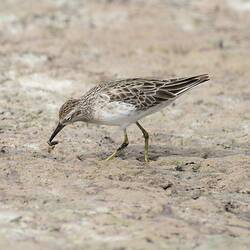General Description
A medium-sized wader with a mottled chestnut-brown upper body. Feathers have a dark centre. The top of the head is bright chestnut. Underparts are white with pale brown streaks on the breast and sides of the belly. Has a curved white stripe above the eye and a brown stripe through the eye. The legs are yellow-green. Their plumage is duller during the non-breeding season. The bill is black with an olive-grey base. Body is up to 24 cm.
Biology
Sharp-tailed Sandpipers are migratory shorebirds. They breed in Siberia and then migrate to Australia, arriving in September and departing in February-March. They form large flocks and are commonly seen with other waders foraging on the grassy edges of shallow waters. They eat aquatic insects and their larvae, molluscs, crustaceans, worms and occasionally seeds. They breed from June to August during the short Siberian summer. Nests are a shallow hollow lined with leaves and grass, hidden on the ground. The usual clutch size is four eggs. Females incubate the eggs and raise the chicks.
Distribution
Summer migrant to Asia and Australasia. Within Australia, found throughout the mainland and Tasmania.
Habitat
Shallow inland freshwater wetlands, mudflats, saltmarshes, mangroves, rocky shores and beaches. Breeding habitat consists of peat-hummock and lichen tundra in Siberia.
More Information
-
Animal Type
-
Animal SubType
-
Brief Id
A brown and yellow-brown migratory shorebird with a white eyebrow, chestnut crown and brown streaks on white underparts.
-
Colours
Brown, White, Yellow
-
Maximum Size
24 cm
-
Habitats
-
Diet
Carnivore
-
Diet Categories
Crustaceans, Insects, Worms
-
Endemicity
-
Conservation Statuses
CITES: Not listed, FFG Threatened List: Not listed, EPBC Act 1999: Not listed, IUCN Red List: Least Concern
-
Taxon Name
-
Common Name
Sharp-tailed Sandpiper
-
Kingdom
-
Phylum
-
Subphylum
-
Class
-
Order
-
Family
-
Genus
-
Species Name
acuminata







